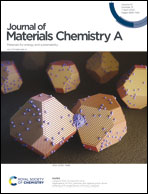Redox and conductive underwater adhesive: an innovative electrode material for convenient construction of flexible and stretchable supercapacitors†
Abstract
Flexible supercapacitors (SCs) are promising energy storage devices for wearable and soft technologies. However, efforts to achieve reliable performance during mechanical deformation have been unsuccessful owing the inevitable displacement and separation between electrode coatings and electrolytes or current collectors, which usually results in an increase of interfacial contact resistance. To address this challenge, we herein explored a kind of redox and conductive underwater adhesive as an electrode coating to improve interfacial adhesion and reduce the interfacial contact resistance. This kind of underwater adhesive, that merges the redox activity of heteropoly acids, the adhesion of aromatic amino acids and the conduction of silver powder into a single system, showcases collective advantages, such as exceptional adhesion to flexible substrates and electrolytes, adaptive and deformable features, conductivity, reversible redox behaviour and fast electron transfer/storage abilities. The all-in-one adhesives could be directly employed as both anode and cathode coatings for the convenient fabrication of a flexible supercapacitor. The capacitance retention of the flexible supercapacitor was found to be kept at 86% and 94% upon stretching and bending deformation, respectively. An electric watch can be easily lighted up by a serially flexible supercapacitor device, and the brightness of the electric watch remains unchanged during stretching and bending processes, indicative of outstanding reliability.



 Please wait while we load your content...
Please wait while we load your content...